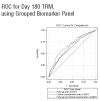The prognostic value of serum C-reactive protein, ferritin, and albumin prior to allogeneic transplantation for acute myeloid leukemia and myelodysplastic syndromes
- PMID: 27662010
- PMCID: PMC5394859
- DOI: 10.3324/haematol.2016.145847
The prognostic value of serum C-reactive protein, ferritin, and albumin prior to allogeneic transplantation for acute myeloid leukemia and myelodysplastic syndromes
Abstract
We sought to confirm the prognostic importance of simple clinically available biomarkers of C-reactive protein, serum albumin, and ferritin prior to allogeneic hematopoietic cell transplantation. The study population consisted of 784 adults with acute myeloid leukemia in remission or myelodysplastic syndromes undergoing unrelated donor transplant reported to the Center for International Blood and Marrow Transplant Research. C-reactive protein and ferritin were centrally quantified by ELISA from cryopreserved plasma whereas each center provided pre-transplant albumin. In multivariate analysis, transplant-related mortality was associated with the pre-specified thresholds of C-reactive protein more than 10 mg/L (P=0.008) and albumin less than 3.5 g/dL (P=0.01) but not ferritin more than 2500 ng/mL. Only low albumin independently influenced overall mortality. Optimal thresholds affecting transplant-related mortality were defined as: C-reactive protein more than 3.67 mg/L, log(ferritin), and albumin less than 3.4 g/dL. A 3-level biomarker risk group based on these values separated risks of transplant-related mortality: low risk (reference), intermediate (HR=1.66, P=0.015), and high risk (HR=2.7, P<0.001). One-year survival was 74%, 67% and 56% for low-, intermediate- and high-risk groups. Routinely available pre-transplant biomarkers independently risk-stratify for transplant-related mortality and survival.
Copyright© Ferrata Storti Foundation.
Figures



Similar articles
-
Impact of pre-transplant serum ferritin on outcomes of patients with myelodysplastic syndromes or secondary acute myeloid leukaemia receiving reduced intensity conditioning allogeneic haematopoietic stem cell transplantation.Leuk Res. 2010 Jun;34(6):723-7. doi: 10.1016/j.leukres.2009.10.028. Epub 2009 Nov 26. Leuk Res. 2010. PMID: 19944463
-
Multicenter validation of scoring system of pre-transplant serum ferritin and disease risk in patients with acute myeloid leukemia and myelodysplastic syndrome after allogeneic hematopoietic stem cell transplant.Leuk Lymphoma. 2013 Jun;54(6):1318-20. doi: 10.3109/10428194.2012.730613. Epub 2012 Nov 1. Leuk Lymphoma. 2013. PMID: 22989327 No abstract available.
-
Impact of the revised International Prognostic Scoring System, cytogenetics and monosomal karyotype on outcome after allogeneic stem cell transplantation for myelodysplastic syndromes and secondary acute myeloid leukemia evolving from myelodysplastic syndromes: a retrospective multicenter study of the European Society of Blood and Marrow Transplantation.Haematologica. 2015 Mar;100(3):400-8. doi: 10.3324/haematol.2014.116715. Epub 2014 Dec 31. Haematologica. 2015. PMID: 25552702 Free PMC article.
-
Transplant for MDS: challenges and emerging strategies.Best Pract Res Clin Haematol. 2015 Mar;28(1):43-54. doi: 10.1016/j.beha.2014.11.006. Epub 2014 Dec 4. Best Pract Res Clin Haematol. 2015. PMID: 25659729 Review.
-
Allogeneic transplantation for the elderly patient with acute myelogenous leukemia or myelodysplastic syndrome.Semin Hematol. 2006 Apr;43(2):107-17. doi: 10.1053/j.seminhematol.2006.01.004. Semin Hematol. 2006. PMID: 16616044 Review.
Cited by
-
C-reactive protein may be a prognostic factor for the whole gastroenteropancreatic neuroendocrine tumor group.World J Gastrointest Oncol. 2019 Feb 15;11(2):139-152. doi: 10.4251/wjgo.v11.i2.139. World J Gastrointest Oncol. 2019. PMID: 30788040 Free PMC article.
-
Investigation of Serum Albumin as a Dynamic Treatment-Specific Surrogate for Outcomes in Patients With Myelofibrosis Treated With Ruxolitinib.JCO Precis Oncol. 2024 Mar;8:e2300593. doi: 10.1200/PO.23.00593. JCO Precis Oncol. 2024. PMID: 38484210 Free PMC article.
-
Myeloablative conditioning in cord blood transplantation for acute myeloid leukemia patients is efficacious only until age 55.Bone Marrow Transplant. 2025 Apr;60(4):458-466. doi: 10.1038/s41409-025-02508-2. Epub 2025 Jan 21. Bone Marrow Transplant. 2025. PMID: 39838078 Free PMC article.
-
Transplant Eligible and Ineligible Elderly Patients with AML-A Genomic Approach and Next Generation Questions.Biomedicines. 2024 Apr 29;12(5):975. doi: 10.3390/biomedicines12050975. Biomedicines. 2024. PMID: 38790937 Free PMC article. Review.
-
Nomogram for Predicting Early Mortality after Umbilical Cord Blood Transplantation in Children with Inborn Errors of Immunity.J Clin Immunol. 2023 Aug;43(6):1379-1392. doi: 10.1007/s10875-023-01505-8. Epub 2023 May 8. J Clin Immunol. 2023. PMID: 37155023 Free PMC article.
References
-
- Wong R, Giralt SA, Martin T, et al. Reduced-intensity conditioning for unrelated donor hematopoietic stem cell transplantation as treatment for myeloid malignancies in patients older than 55 years. Blood. 2003;102(8):3052–3059. - PubMed
-
- Lee SJ, Klein J, Haagenson M, et al. High-resolution donor-recipient HLA matching contributes to the success of unrelated donor marrow transplantation. Blood. 2007;110(13):4576–4583. - PubMed
-
- Pulsipher MA, Boucher KM, Wall D, et al. Reduced-intensity allogeneic transplantation in pediatric patients ineligible for myeloablative therapy: results of the Pediatric Blood and Marrow Transplant Consortium Study ONC0313. Blood. 2009;114(7):1429–1436. - PubMed
-
- Gratwohl A, Hermans J, Goldman JM, et al. Risk assessment for patients with chronic myeloid leukaemia before allogeneic blood or marrow transplantation. Chronic Leukemia Working Party of the European Group for Blood and Marrow Transplantation. Lancet. 1998; 352(9134):1087–1092. - PubMed
Publication types
MeSH terms
Substances
Grants and funding
LinkOut - more resources
Full Text Sources
Other Literature Sources
Medical
Molecular Biology Databases
Research Materials

